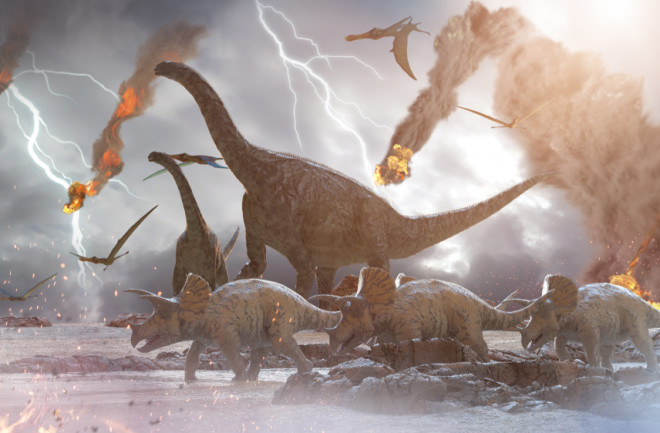In the late Cretaceous, dinosaurs ruled the earth. They were the most diverse and widespread land animals on the planet.
“Most major terrestrial niches were occupied by dinosaurs, particularly toward the end of the Cretaceous,” says Chris Torres, an Ohio University post-doctoral researcher and paleontologist.
Dinosaurs were not monolithic. They were ferocious predators, horned mega-herbivores, feathered scavengers and pint-sized foragers.
The Cretaceous Extinction
65 million years ago, the vast majority of these ancient reptiles disappeared from the fossil record. It’s a mystery that has fascinated scientists and schoolchildren for decades (as well as school children that go on to become scientists, like Torres).
Dinosaurs were not the only victims of the extinction. More than 60 percent of species perished globally. In the oceans, entire genera of invertebrates died out. On land, gymnosperms and angiosperms, groups that include most modern trees, barely survived.
The cause of the Cretaceous-Tertiary (K-T) extinction or Cretaceous-Paleogene (KPg) extinction, as it is interchangeably called, has been hotly debated within the scientific community. However, most experts agree that one particular event is an important, if not complete, cause.
Read More: 7 of the Scariest Dinosaurs the World Has Ever Seen
Where Did the Meteor That Killed the Dinosaurs Land?
At the close of the Cretaceous, a large meteor descended upon the Yucatan peninsula in present-day Mexico. The impact ejected magma, debris and vapors into the atmosphere, ignited wildfires and sent towering tsunamis across the globe.
A period of intense cold and darkness followed an initial heatwave, as aerosols and particulates blocked out the sun. Sulfates from the atmosphere acidified the oceans.
What you didn’t know about the KT extinction:
Researchers debate whether the asteroid strike caused or merely contributed to the die-off.
Large-scale volcanic activity in India’s Deccan Traps was already underway before the impact.
Dinosaurs had survived the late Triassic mass extinction, but couldn’t survive this one.
What Happened After the Meteor?
Eventually, time tempered the catastrophic climate of the KT extinction event. As conditions became livable again, survivors of the event flourished and diversified. These organisms are the ancestors of life as we know it.
Mammals, a relatively unremarkable group of small nocturnal organisms during the Cretaceous, proliferated during the Paleogene. The absence of dinosaurs allowed them to expand into new, diverse ecological roles. Big, leafy angiosperms, previously outnumbered by gymnosperms, gave birth to modern rainforests. In many places, these survivors co-evolved to rely on each other.
Read More: What Did the End Look Like For Dinosaurs?
Descendants of Dinosaurs
One group of dinosaurs remained: birds. As is the case with most survivors of the KT extinction, it’s unclear exactly why. In a recent paper published in Science Advances, Torres and his colleagues proposed a theory: birds may have survived because of their brains.
“Birds are incredibly intelligent organisms,” says Torres. “Some groups of birds, like parrots and crows, have a density of brain cells that is so high that it surpasses most mammals, even most primates.”
To gain insight into the evolution of modern bird brains, the researchers focused on birds’ evolutionary cousins: Ichthyornis. These toothed sea-faring ornithurians were closely related to the ancestors of modern birds, but they did not survive the KT extinction.
Using a fossil of an Ichthyornis skull, the scientists recreated a model of its brain. Despite other similarities between the relatives, the Ichthyornis’ brain was structured in a fundamentally different way from the brain of a modern bird.
“The forebrain of modern birds is gigantic relative to the rest of the brain,” Torres says. “Much more so than apparently all other birds that would have been around at the end of the Cretaceous.”
Read more: What Species Today Are Descendants of Dinosaurs?
How Did Birds Survive the Mass Extinction?
Torres warns anyone against thinking of this as evidence that birds survived “because they were smarter.” However, their evolutionary success seems tied to their cognitive function somehow. Humans process sensory information and critical decision-making in the forebrain. In birds, something like critical thinking skills may have allowed them to develop tactics for surviving in a post-meteor impact wasteland.
“It probably had something to do with behavioral plasticity, the ability to draw from a wide repertoire of behaviors depending on what circumstances are like around you,” Torres says.
Sixty-five million years later, birds are some of the most evolutionary successful animals on the planet. They occupy many ecological niches that were once dominated by their cousins, the non-avian dinosaurs. In a sense, they have inherited the earth.
“There are no other terrestrial vertebrates that are as successful or diverse as birds,” Torres proclaims.
Read More: Did Humans and Dinosaurs Ever Live Together?

